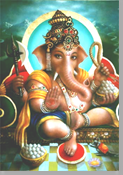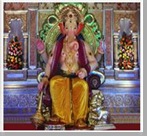
Ganesh Chaturthi and Lalbaughcha Raja
Tomorrow is Ganesh Chaturthi and the mood is festive. So let's know more about this festival in general and the Famous Lal Bagh Ganesh in particular. Most of the Cities in India have temples devoted to Lord Ganesha and tomorrow you would find huge crowd worshipping Lord Ganesha on his Birthday.
About Ganesh Chaturthi
 According to the legend, Lord Shiva, the Hindu God of resolution, was away at a war. His wife Pavarti, wanted to bathe and having no-one to guard the door to her house, conceived of the idea of creating a son who could guard her. Parvati created Ganesha out of the sandalwood paste that she used for her bath and breathed life into the figure. She then set him to stand guard at her door and instructed him not to let anyone enter.
According to the legend, Lord Shiva, the Hindu God of resolution, was away at a war. His wife Pavarti, wanted to bathe and having no-one to guard the door to her house, conceived of the idea of creating a son who could guard her. Parvati created Ganesha out of the sandalwood paste that she used for her bath and breathed life into the figure. She then set him to stand guard at her door and instructed him not to let anyone enter.
In the meantime, Lord Shiva returned from the battle but as Ganesha did not know him, stopped Shiva from entering Parvati's chamber. Shiva, enraged by Ganesh’s impudence, drew his sword and cut off Ganesha's head. Pavarti emerged to find Ganesha decapitated and flew into a rage. She took on the form of the Goddess Kali and threatened destruction to the three worlds of Heaven, Earth and the subterranean earth.
Seeing her in this mood, the other Gods were afraid and Shiva, in an attempt to pacify Parvati, sent out his ganas, or hordes, to bring the head of the first living being with his head towards the north (the auspicious direction associated with wisdom). The first living thing they came across was an elephant. So they brought the head of this elephnat and Shiva placed it on the trunk of Parvati's son and breathed life into him. Parvati was overjoyed and embraced her son, the elephant-headed boy whom Shiva named Ganesha, the lord of his ganas.
About Lalbaughcha Ganesh
 Each state in India has its favourite deity. In Bengal, it is Goddess Durga, in Kerala, it is Lord Iyyappa and in Tamilnadu, it is Lord Murugan. In Maharashtra, it is Ganpati and on his birthday on Ganesh Chaturthi (which falls on September 3, 2008), till the immersion of the idol on September 14, it is 11 days of total revelry. The statistics are benumbing:
Each state in India has its favourite deity. In Bengal, it is Goddess Durga, in Kerala, it is Lord Iyyappa and in Tamilnadu, it is Lord Murugan. In Maharashtra, it is Ganpati and on his birthday on Ganesh Chaturthi (which falls on September 3, 2008), till the immersion of the idol on September 14, it is 11 days of total revelry. The statistics are benumbing:
Number of sarvajanik (community) Ganesh pandals in 2007: 11828
Number of homes that kept idols in 2007: 1,41,618
Number of idols immersed in 2007 at Girgaum Chowpatty - the most popular site for immersions: 12,138
Number of immersion spot across Mumbai: 59
Police force deployed for Ganeshotsav: 35,000
Homeguards required for helping the police: 10,000
State reserve police force to be deployed: 5,000
And the most important of them all is the famous idol known as Lalbaughcha Raja. The already grandiose Lalbaugcha Raja is all set to get an even more grand birthday in 2008 – its 75th year of inception – when 10 million devotees are expected to pay their respects to him in those eleven days of celebration.
Every year, at any given moment, some 15,000 devotees get a glimpse of the Lord. The reason for its popularity is the belief that Lalbaughcha Raja Ganapati fulfils every pilgrim’s wishes. The trust in the deity is so strong that thousands make bookings for the puja a year in advance.
The Mandal for the 11-days darshan is known as ‘Lalbaugcha Raja Sarvajani Ganeshotsav Mandal’ founded in the year 1934. There was a market in its place earlier and it was shut down in 1932. The fishermen and the vendors who used to make a living there prayed to Lord Ganesh for a permanent place for their market. The Lord granted the request. In return, the fishermen and the traders installed a Ganesha Idol (dressed in the traditional attire of fishermen) on Ganesh Chaturthi in 1934.
Every day of the celebrations, the idol is dressed in a yellow pitamber (dhoti), a stole and a kambar patta (waistbelt) – which cost around Rs 20,000 this year – twice every day – at 3 am and 3 pm. Hence, 22 sets of attire are required every year for the festival. Lalbaugcha Raja, needs 39 metres of cloth for the pitamber alone. The stole and waistbelt are about six metres long, which is equivalent to the length of a saree. Besides this, the idol is adorned with approximately seven to eight kilograms of gold, the main attraction being a golden crown of two kg, gold bracelets and other ornaments. From the year 2005, a silver-and-gold protection for the idol’s feet was also added to the decoration. At a cost of Rs 6 lakh to Rs 8 lakh, the Mandal – one of the richest in the city, had commissioned a covering that was made of 20 kg of silver and 300 grams of gold.
“For several years, we have been noticing that after being repeatedly touched by devotees, the idol’s feet, made of plaster of paris, were getting eroded,” says Sunil Joshi, Chairman of the Mandal. In 2004, Supriya Pilgaonkar (actor Sachin’s wife) who had visited the Raja for the first time, held on to his feet for almost 15 minutes. So, in 2005, we decided it was time to get a protective covering for the God’s feet,” he adds.
The VIPs who visit the idol every year include Bappi Lahiri, Lata Mangeshkar, Asha Bhonsle, and Sachin Tendulkar’s family. “Lata Mangeshkar regularly donates 11 gold coins to the Raja during every visit,” adds Sunil.
Lalbaugcha Raja, attracted two million devotees over the weekend in 2007 and this year the total number of pilgrims is expected to touch 10 million. Devotees have to queue up for over nine hours to catch a glimpse of the Lalbaug mandal idol. “On an average it takes nearly 14 hours for a devotee to walk one kilometre from the starting point of the queue at nearby Kalachowkie to the podium at Lalbaugcha Raja Society,” says one pilgrim. In an hour 10,000 people get to view the idol. An equal number manages to get to the main podium, and this second queue - called the navsa line - consists of devotees who line up for both thanking the Lord and seeking further blessings.
Traditionally the Ganesh idols are immersed in water during the final visarjan. The procession accompanying it takes almost the whole day before it reaches Girgaum Chowpatty. Hence in order to immerse the idol of the Raja, Mandal always takes proper precautions so that the visarjan takes place in a manner the Raja deserves. Accordingly, after consulting experts the Mandal has purchased a tarafa (Iron raft) which makes it possible to immerse the idol of Lalbaugcha Raja in the sea away from the shore.
The best part of this grand festival is that, after the immersion, the offerings are auctioned to devotees and the proceeds are given away for noble causes.
At Lalbagcha Raja, the gold and silver offerings added up to about Rs three crore in 2007. By auctioning all the valuables, the Mandal got nearly Rs five crore in 2007. The most expensive item auctioned was a 32-tola gold necklace: for Rs 4,15,000. A silver mouse was sold for Rs 2,85,000. The cash donation amounted to over Rs one crore. This year the mandal expects at least six crores in the auction, which will be given away to the needy.
